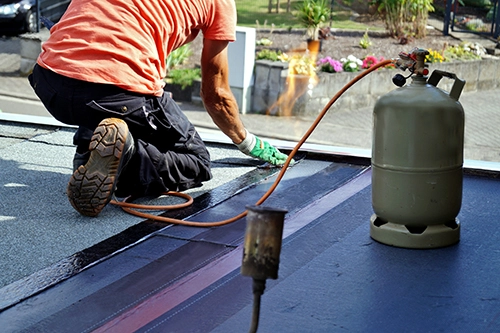- About Us
- Services
- Blog
- Contact
Need a quote?
Roof maintenance is important, and although there are many benefits to working with roofing contractors, it can be tempting to take on some of the work yourself.
But is DIY roof maintenance really worth the effort? And when should you be sure to get the experts in.




Before doing anything with your roof, you should always keep two basic safety principles in mind: visibility and stability.
As a rule, this is why most experts prefer to work on roofs during the summer, when daylight hours are longer and there is less chance of poor weather conditions, such as frost and rain.
They also work with full scaffolding, which adds a lot of stability, particularly if you’re working on a sloped roof. Now, we certainly don’t expect DIYers to be contacting their local scaffolders, but if you are going to do some work on your roof, then make sure that the weather conditions are ideal and that you have a good, sturdy ladder.
To an extent, this depends on how much you’re willing to learn. Basic jobs, such as cleaning off moss or replacing one or two chipped tiles, are fairly simple. Although the placement of tiles can vary quite a bit depending on which type you have, once you’re up there, this should be fairly intuitive to work out.
On the other hand, if you’re looking to fully replace all the tiles or conduct major repairs to either tiles or underlay, then we really recommend contacting specialists.
Roof maintenance can be a major undertaking, and inexperience can lead to delays, plus, it can be pretty dangerous up there. If weather conditions aren’t ideal, this could put your house at serious risk as roof tiles form the bulk of waterproofing yet need to be removed in order to perform any large-scale work.
The other big benefit to getting in touch with professionals is that they can provide a clear timeframe for when work will be completed. They know the job inside and out, so you’ll be able to proceed with full confidence and certainty.
When all’s said and done, your mileage may vary on how much DIY you’re willing to put into a job like this, but what won’t vary is the need for sturdy, durable roofing. When you hire roofing contractors, you’re investing in the future of your home.
For the best in roof repair, contact us today by calling 020 4572 3059 or emailing info@environroofingservices.co.uk and our team will be more than happy to help.
It depends on the construction, but the minimum weight a flat roof must be capable of bearing is 300lbs. This refers to a concentrated weight where a load is positioned on just one area of the roof. So, for example, a commercial flat roof can approximately support a 300lb HVAC unit in a 2.5×2.5ft single space.
If you opt for a flat roof anywhere on your property, remember that it comes with a need for proper maintenance. Low-slope roofing London-wide should be checked every six months or so, or after spells of bad weather, to spot any signs of damage. No matter how small, these should be addressed before they escalate. Remove any debris (leaves, twigs and so on) regularly to avoid these blocking the gutters and allowing water to pool and stand on the roof.
If there are trees in the close vicinity, keep them cut back to reduce the amount of foliage that falls on your flat roof. And check internally for signs of moisture, dampness or water damage on a regular basis. Spotting problems early means resolving them will be cheaper in the long run.

Building a flat roof can be done in three ways. The simplest and most cost-effective choice for levelled roofing London-wide is to construct a warm roof where a roofing membrane is placed over the insulation that keeps the timber structure warm. Another option is to create a cold roof where insulation is positioned between the rafters under the ply roof covering. This is commonly applied to flat-roofed extensions.
The third method is the hybrid roof that contains diverse elements. Their designs require a gap of ventilation above a warm roof to prevent excess moisture within the roof structure.
If you’re looking for flat roofing local contractors, don’t just select the first firm you come across. Find a roofing company that’s been in business for a while and can demonstrate a good track record in installing, repairing, and replacing flat roofs specifically. Ask for recommendations from your own network or from a local trade association. If you need refurbishment work done to 50% or more of your roof, you’ll need a roofing contractor who can self-certify their work under the Competent Person Scheme. Otherwise, the Building Control department at your local authority will need to approve the job before it begins.
Ask whether they are covered by liability insurance and how long they’ll guarantee the work they will carry out. And never just opt for the cheapest quote unless you’re quite sure they’re the best company for the job. You can’t afford to compromise on your roof as the structural integrity of your property depends on it.
Ensuring your flat roof will comply with building regulations before installation can save property owners time, money and stress. First, the roof must have a slope of around 1:80, with water draining away to one or two roof edges. Waterproofing must be extended up to the adjacent walls with at least 150 mm from the surface of the roof.
Contractors must install ventilation in cold roofs. For warm roofs, the deck must be bonded with a VCL. The roof should have the capacity to withstand strong winds and be sturdy enough to take an individual’s weight. Finally, check whether planning permission is needed. Typically, this is only required if you live in a conservation area or a listed building, or are making significant changes to an existing roof.
If you’re looking for top roofing solutions at competitive rates, check out our range of roofing services at Environ Roofing Company London. To get started, call one of our representatives today!

